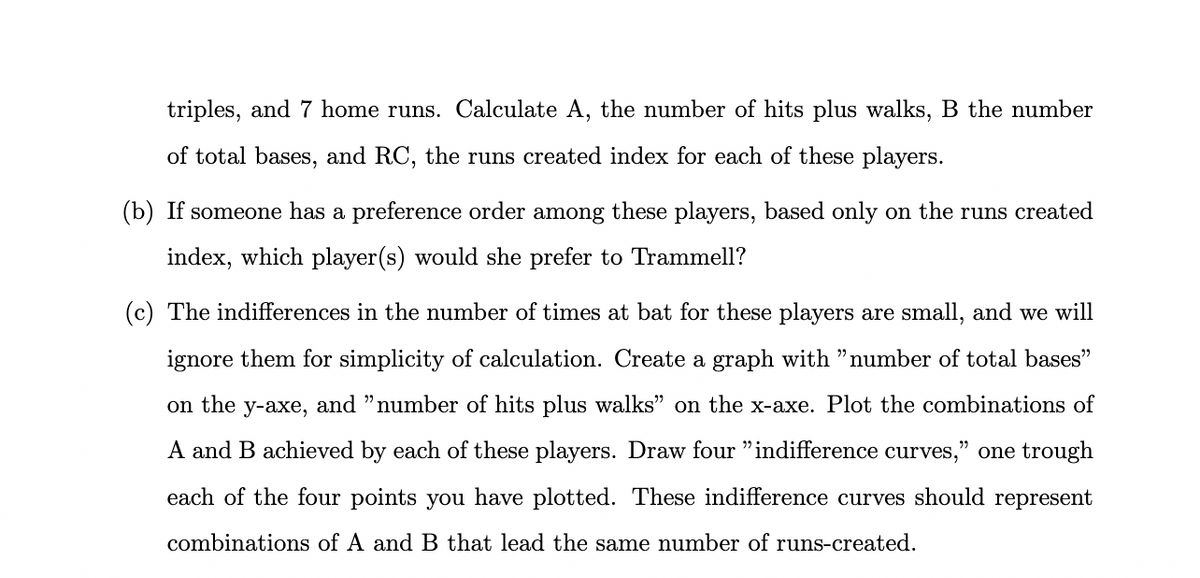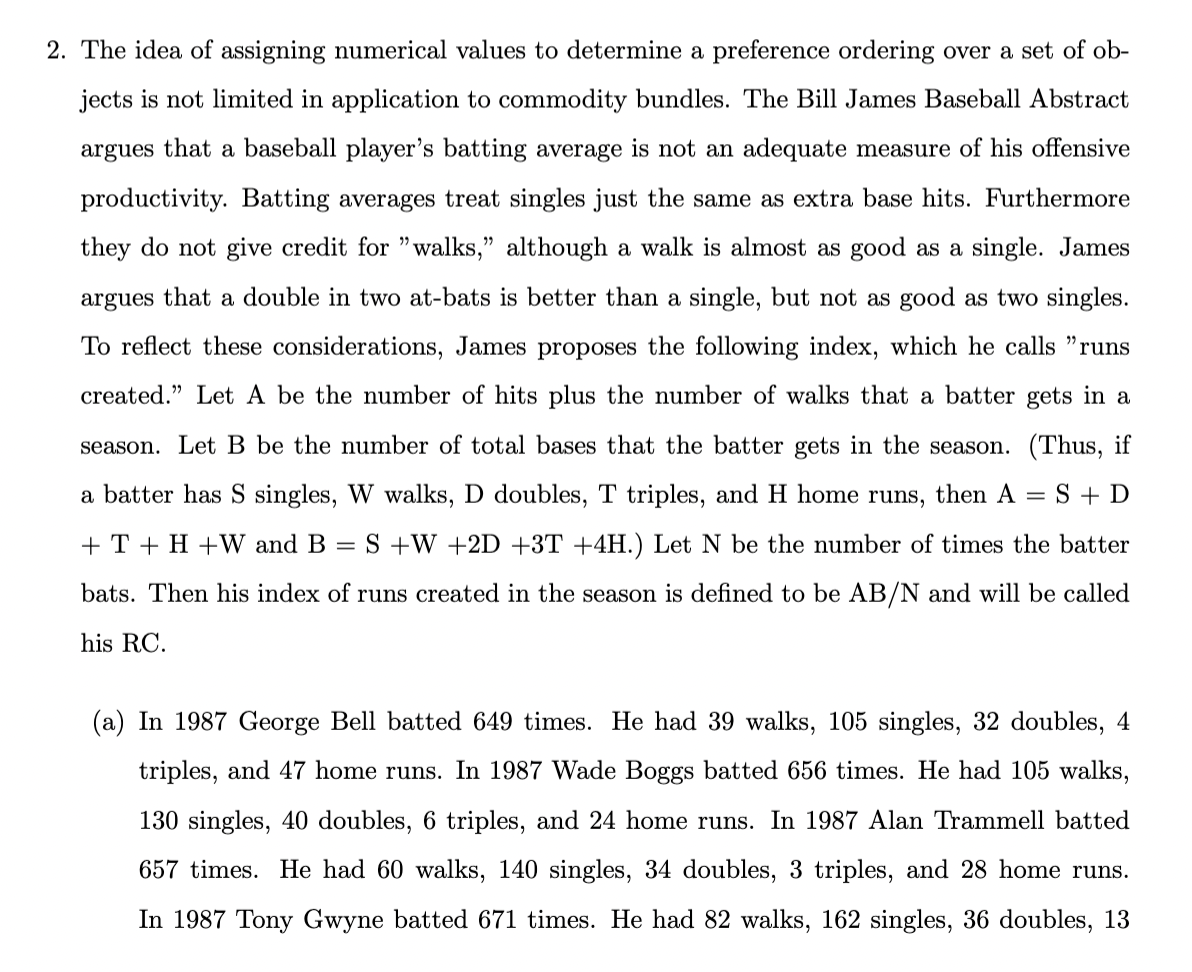The idea of assigning numerical values to determine a preference ordering over a set of ob- jects is not limited in application to commodity bundles. The Bill James Baseball Abstract argues that a baseball player's batting average is not an adequate measure of his offensive productivity. Batting averages treat singles just the same as extra base hits. Furthermore they do not give credit for "walks," although a walk is almost as good as a single. James argues that a double in two at-bats is better than a single, but not as good as two singles. To reflect these considerations, James proposes the following index, which he calls "runs created." Let A be the number of hits plus the number of walks that a batter gets in a season. Let B be the number of total bases that the batter gets in the season. (Thus, if a batter has S singles, W walks, D doubles, T triples, and H home runs, then A = S + D + T + H+W and B = S +W +2D +3T +4H.) Let N be the number of times the batter bats. Then his index of runs created in the season is defined to be AB/N and will be called his RC. (a) In 1987 George Bell batted 649 times. He had 39 walks, 105 singles, 32 doubles, 4 triples, and 47 home runs. In 1987 Wade Boggs batted 656 times. He had 105 walks, 130 singles, 40 doubles, 6 triples, and 24 home runs. In 1987 Alan Trammell batted 657 times. He had 60 walks, 140 singles, 34 doubles, 3 triples, and 28 home runs. In 1987 Tony Gwyne batted 671 times. He had 82 walks, 162 singles, 36 doubles, 13
The idea of assigning numerical values to determine a preference ordering over a set of ob- jects is not limited in application to commodity bundles. The Bill James Baseball Abstract argues that a baseball player's batting average is not an adequate measure of his offensive productivity. Batting averages treat singles just the same as extra base hits. Furthermore they do not give credit for "walks," although a walk is almost as good as a single. James argues that a double in two at-bats is better than a single, but not as good as two singles. To reflect these considerations, James proposes the following index, which he calls "runs created." Let A be the number of hits plus the number of walks that a batter gets in a season. Let B be the number of total bases that the batter gets in the season. (Thus, if a batter has S singles, W walks, D doubles, T triples, and H home runs, then A = S + D + T + H+W and B = S +W +2D +3T +4H.) Let N be the number of times the batter bats. Then his index of runs created in the season is defined to be AB/N and will be called his RC. (a) In 1987 George Bell batted 649 times. He had 39 walks, 105 singles, 32 doubles, 4 triples, and 47 home runs. In 1987 Wade Boggs batted 656 times. He had 105 walks, 130 singles, 40 doubles, 6 triples, and 24 home runs. In 1987 Alan Trammell batted 657 times. He had 60 walks, 140 singles, 34 doubles, 3 triples, and 28 home runs. In 1987 Tony Gwyne batted 671 times. He had 82 walks, 162 singles, 36 doubles, 13
Chapter4: Utility Maximization And Choice
Section: Chapter Questions
Problem 4.2P
Related questions
Question

Transcribed Image Text:triples, and 7 home runs. Calculate A, the number of hits plus walks, B the number
of total bases, and RC, the runs created index for each of these players.
(b) If someone has a preference order among these players, based only on the runs created
index, which player(s) would she prefer to Trammell?
(c) The indifferences in the number of times at bat for these players are small, and we will
ignore them for simplicity of calculation. Create a graph with "number of total bases"
on the y-axe, and "number of hits plus walks" on the x-axe. Plot the combinations of
A and B achieved by each of these players. Draw four "indifference curves," one trough
each of the four points you have plotted. These indifference curves should represent
combinations of A and B that lead the same number of runs-created.

Transcribed Image Text:2. The idea of assigning numerical values to determine a preference ordering over a set of ob-
jects is not limited in application to commodity bundles. The Bill James Baseball Abstract
argues that a baseball player's batting average is not an adequate measure of his offensive
productivity. Batting averages treat singles just the same as extra base hits. Furthermore
they do not give credit for "walks," although a walk is almost as good as a single. James
argues that a double in two at-bats is better than a single, but not as good as two singles.
To reflect these considerations, James proposes the following index, which he calls "runs
created." Let A be the number of hits plus the number of walks that a batter gets in a
season. Let B be the number of total bases that the batter gets in the season. (Thus, if
a batter has S singles, W walks, D doubles, T triples, and H home runs, then A S + D
+T+ H+W and B = S +W +2D +3T +4H.) Let N be the number of times the batter
bats. Then his index of runs created in the season is defined to be AB/N and will be called
his RC.
=
(a) In 1987 George Bell batted 649 times. He had 39 walks, 105 singles, 32 doubles, 4
triples, and 47 home runs. In 1987 Wade Boggs batted 656 times. He had 105 walks,
130 singles, 40 doubles, 6 triples, and 24 home runs. In 1987 Alan Trammell batted
657 times. He had 60 walks, 140 singles, 34 doubles, 3 triples, and 28 home runs.
In 1987 Tony Gwyne batted 671 times. He had 82 walks, 162 singles, 36 doubles, 13
Expert Solution
This question has been solved!
Explore an expertly crafted, step-by-step solution for a thorough understanding of key concepts.
This is a popular solution!
Trending now
This is a popular solution!
Step by step
Solved in 4 steps with 2 images

Knowledge Booster
Learn more about
Need a deep-dive on the concept behind this application? Look no further. Learn more about this topic, economics and related others by exploring similar questions and additional content below.Recommended textbooks for you


Principles of Economics 2e
Economics
ISBN:
9781947172364
Author:
Steven A. Greenlaw; David Shapiro
Publisher:
OpenStax

Principles of Microeconomics
Economics
ISBN:
9781305156050
Author:
N. Gregory Mankiw
Publisher:
Cengage Learning


Principles of Economics 2e
Economics
ISBN:
9781947172364
Author:
Steven A. Greenlaw; David Shapiro
Publisher:
OpenStax

Principles of Microeconomics
Economics
ISBN:
9781305156050
Author:
N. Gregory Mankiw
Publisher:
Cengage Learning

Exploring Economics
Economics
ISBN:
9781544336329
Author:
Robert L. Sexton
Publisher:
SAGE Publications, Inc


Principles of Microeconomics (MindTap Course List)
Economics
ISBN:
9781305971493
Author:
N. Gregory Mankiw
Publisher:
Cengage Learning